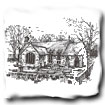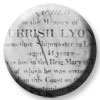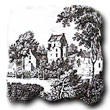The Mary of London
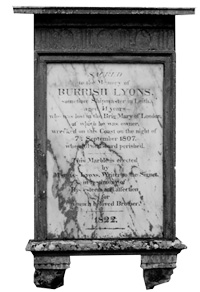
Walk out of the Main Door of this Church straight across the grass for ten yards and you will find set into the wall on your left a memorial tablet in white marble.
The inscription reads -
“Sacred to the memory of Burrish Lyons one time Shipmaster in Leith aged 41 years who was lost on the Brig Mary of London of which he was owner wrecked on this coast on the night of 7th September 1807”.
To understand the story of the "Mary" better it should be remembered that in 1807 the town of Cullen was not where it stands today.
The Church and Churchyard were literally at the heart of the town with Cullen's one long main street running past the Churchyard gates, stretching towards the foot of the Castle Hill in one direction and curving round towards the top of the Lintmill Brae in the other.
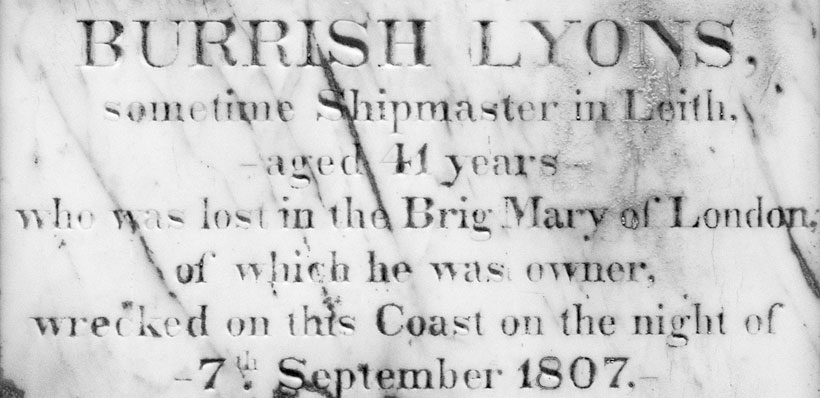
Dr William Cramond, Cullen's noted 19th century historian records in his book "Old Memories" that the night the "Mary" was lost was very stormy with a strong wind from the south - east. The lights of a vessel were seen in Cullen Bay. Next morning the rocks at the Scaur Nose near the Bow Fiddle were strewn with wreckage with rigging, logs, spars, webs of silk, etc., scattered about. All the crew had perished.
It is reported that no body was found entire. The raging seas and the jagged rocks had seen to that. The body of the ship's master, Burrish Lyons, could be identified.
It is said that he was a man like Esau and, from the Bible, we know that Esau was a very hairy man. Burrish Lyons was known to be a Christian and his body was buried in the Churchyard. What remains of the crew that were recovered were buried behind the jail which was adjacent to the Churchyard gates.
One particularly sad part of the story is that it is recorded that, when Burrish Lyons' body was found, clasped around his neck were the arms of a boy - no doubt the cabin boy whom he had been trying to save. The Rev. John T. Guthrie, in his booklet tracing the history of our Auld Kirk, includes a poem printed in 1945 and penned by someone simply calling himself "Historicus".
The poem extols the beauty of the Auld Kirk and reference is made to some of those laid to rest in the Churchyard. One of the verses refers to the wreck of the "Mary".
"By yonder gates, 0' erwhelmed by luckless stroke,
The gallant seamen lie, whose vessel broke
Asunder on the Scaurnose long ago,
Shivered then vanished, like a wisp of smoke."
It would be wrong to say that Cullen benefited from this tragedy.
But some of the spars washed ashore were used to make a bridge across the mouth of the Cullen Burn which previously had had to be forded. The bridge could not have been a very sturdy structure for it came to be known locally as the "Shooglie Briggie". (For those not acquainted with the Doric, that's the Shaky Bridge.) "Shooglie Briggie" is much more descriptive, isn't it.
And some benefit - if that is the right word - came to this Church too. The pulpit needed repair. The Earl of Seafield of the time was Vice-Admiral of Scotland and as such had the right to all wrecks on the Moray Firth coast. He gave permission for some of the fine oak panelling from the saloon of the "Mary" to be presented to the minister, the Rev. Robert Grant, for renovation to the pulpit of our Church.
In his book, "Church Annals of Cullen", The Rev. Dr. W. G. Robertson, Minister of this Church in the 1930s writes, " I have it on the excellent authority of the late Mr. John Forbes of Anvil Cottage, Cullen, who had the information from his parents, this application of the panelling to the repair of the pulpit was made with the permission of the Earl of Seafield."
The wreck of the "Mary" was bought by local businessman Mr. Thomas Rannie who saw to the burial of the bodies of the crew. When the brother of Burrish Lyons came to Cu1len some years later to erect the marble stone in memory of his brother he publicly thanked Mr. Rannie presenting him with an inscribed silver cup.
Many a fisherman and seaman have lost their lives along our coast in the pursuance of their livelihood. May we remember them all today as we recall the fate that befell the Brig "Mary", her master Burrish Lyons, and all of her crew who perished on the rocks of the Scaur Nose more than 200 years ago.
James Findlay
